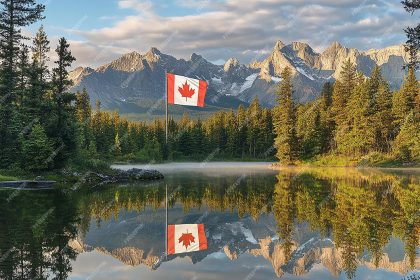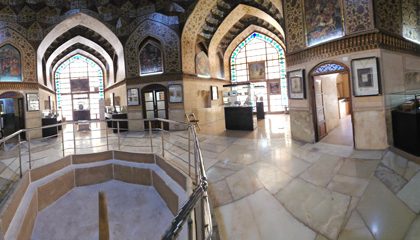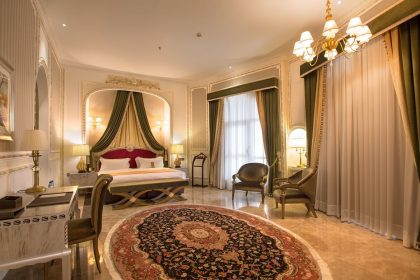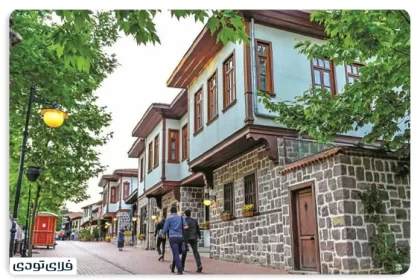Arak is the city of black clouds and thick smoke. Of course, behind this black halo, amazing beauties are hidden. This relatively young city is gradually filled with historical and cultural monuments and natural attractions that many of us have not yet seen or even heard about. That’s why we have written and our goal is to introduce the sights of Arak and the natural and historical attractions of this industrial city.
1. Four seasons historical bath
Even if you are a bit interested in seeing historical places, it is impossible not to enjoy seeing the Four Seasons Bath of Arak, the largest bath in Iran. The reason for the name of this bathroom is the presence of tile paintings of the four seasons on the walls of the men’s bathroom. Here you can see the pinnacle of Iranian tile work at the end of the Qajar era and you can watch its unique decorations for hours. Currently, a part of this bathroom has been dedicated to a museum to store objects obtained from the era before and after Islam.
Address: Arak, Beheshti St., Chaharfasal Hammam
2. government citadel; From the sights of Arak

The glass tower, or the government citadel, was once built as the residence of the ruler and the city’s government center, but despite being registered in the list of national monuments of our country, not much remains of it now and a large part of it has been destroyed! The rhombus-shaped tiles that were used on the top of the citadel shone under the sunlight just like glass, and because of this, this citadel became known as the Glass Tower. Currently, only a part of it, which was the house of Yusuf Khan Sepehdar, remains and can be seen.
Address: Adebjo St., Arak
3. Arak historical market

Travel time is short and you want to kill two birds with one stone? Going to the historical market of Arak is both an omen and a spectacle. You get the things you like, and you walk in a structure that dates back to the era of Feth Ali Shah Qajar. You can even buy Arak souvenirs from this market. This covered market where you can find everything from chicken milk to human life, once had a school, a bathhouse, a caravanserai, and a reservoir, but nothing is left of them today.
Address: Arak, Shahada Square
4. Heftadaghla region

If you would like to see one of the favorite hunting grounds of the Qajar kings, we invite you to visit the painting of Haftadghele in Arak. Dozens of stone inscriptions can be seen on the mountains of this area, which is currently a protected resort, dating back to at least 400 years ago. Also, thanks to the accumulation of mountains, valleys, springs, and streams in this area, various animal and plant species live in it, which is worth watching on a trip to Arak.
Address: 25 kilometers northeast of Arak, between the cities of Arak, Khomin and Mahalat
5. Hassanpour house; From the sights of Arak

One of the most beautiful places to see in Arak, which has a historical atmosphere and the color of traditional Iranian architecture, is Hassanpour House. This 2-story brick building was built in the time of Ahmad Shah Qajar on a 600-meter plot; The first floor is for the winter rooms and the second floor is for the royal rooms. This building is registered in the list of national monuments of our country and now the Arak Handicrafts Museum is open there.
Address: Arak, Imam Khomeini Blvd., Pasdaran St., Bazaar, Sephadari Crossing
6. Tomb of Agha Nuruddin Iraqi

Mr. Nuruddin Iraqi was one of the most influential scholars and one of the great religious leaders. This historical monument was built during the Qajar era in honor of this mujtahid, so that it would be a building worthy of the personality of “Owais Zaman”. Brick walls and fences separate this turquoise-colored tomb from the southern part of the old city cemetery. When you enter the mausoleum, an entrance porch, a shrine and a prayer hall are all you see at first glance. A simple and small altar can be seen in the prayer room.
Address: Arak, Tehran Gate, Old Cemetery
7. Anjdan village; One of the most attractive places to visit in Arak

Anjdan village is one of the thousand-year-old sights of Arak. Here you can see the castles and caravansaries of the Ismaili era, who spent some time in this village after the Mongol attack. If you are a caver, you should definitely visit Giwekash, Kobuter, Asili and Taq Rajah caves, and if you enjoy seeing historical monuments, visit Shah Qalandar’s tomb and Shah Gharib’s tomb. For nature lovers, we suggest watching the Absard spring in the Absard valley.
Address: 37 kilometers east of Arak on the slopes of Cheshme Mountain, between the cities of Khomin, Arak and Mahalat
8. Miqan lagoon

Mighan wetland, which was called Farahan salt marsh in the past, is one of the most beautiful desert wetlands in Iran in the heart of Arak. This region is considered as the paradise of Iranians. Many tourists go to the east of Arak just to see the salt water plants and migratory birds (especially in the middle of November). In the middle of this lagoon, there are 3 islands called Crystalline 1, 2 and 3, on one of which the ruins of an old castle were seen in the past.
Address: 15 kilometers east of Arak (southwest of Dawood Abad)
9. Qanat of Ibrahimabad

Do you want to understand the intellectual and cultural richness and originality of Iranian civilization? Ebrahimabad Qanat will complete your pilgrimage! This aqueduct originates from Haftadqala mountains and reaches Ebrahimabad village after 11 km. It is not easy to go inside this aqueduct, but you can see its exterior and enjoy it. This mesmerizing structure, which represents the art of Iranian architecture and calculations at the end of the Qajar era, has remained intact until today and has been registered in the UNESCO World Heritage List.
Address: Central part of Arak city, Ebrahimabad village
10. rain drop waterfall

Close your eyes and imagine a wide valley with a beautiful view of falling waterfall drops and walls covered with lush vegetation. This waterfall, which some people call “Rain Mountain”, passes through the vegetation and mosses and flows into the aqueduct at the end of this valley. On your trip to Tafaresh, don’t deprive yourself of the pleasure of watching this beautiful waterfall and listening to the pleasant sound of the water flow. This is one of the tourist spots in Tafaresh Arak, which is not less beautiful than the famous waterfalls of Lorestan!
Address: 30 kilometers northwest of Tafaresh, Bazarjan district, near Kurian village
11. Masroop Arak Church

Right in the heart of the most industrialized city of Iran, there is a church that used to be a place of worship for Armenians living in this part of our country. About the architecture of this building, the point that attracts our attention more than anything else is the numerous skylights on the 4 sides of the building and the bell tower that is located in front of its western entrance. Several other parts including school, meeting hall, priest’s house and janitor’s residence are also located in the area of this church.
Address: Arak, Chamran St
12. Sightseeing places of Arak; Haj Vakil castle

One of the sightseeing places of Arak is the Haj Vakil Castle or the Hat Mansion of Arak. This building was originally built for Farsh Ziegler during the era of Naser al-Din Shah Qajar, but later Mohammad Hassan Vakil bought it and became famous after him. Today, the Dayer Handicrafts and Traditional Arts Museum in this castle exhibits valuable works of hand-woven carpets, calligraphy works, calligraphic panels, all kinds of carpets and rugs.
Address: Arak, Student Blvd., the beginning of Hashminejad St
13. Pakel Shazand ski resort

If you go to Arak in the winter season, don’t miss the chance to see the famous Shahada Sarband (Pakal) ski slope. This is one of the best sightseeing places in Shazand in a completely mountainous area and provides you with all the facilities you need for a happy and energetic day. After experiencing tubing on the snow and watching the view of the ski lift, your blood will be full of adrenaline for a long time. After playing and having fun in the complex, you can enter the restaurant to have a meal or rent a suite to relax.
Address: 25 kilometers from Shazand city and 55 kilometers from Arak
14. Historical village of Hazaveh

Hezaveh historical paradise with 5 thousand years old is one of the most beautiful places to see in Arak in spring. You have probably seen this terraced village with the same complex texture in Masoleh, Gilan. In this area, the houses are made of stone, mud and wood, and the roof of the lower house is the upper neighbor’s yard. Since great men like Amir Kabir and Qaim Maqam Farahani were born in this village, some people call it the birthplace of the dead of history. Whenever you pass by this historical village, be sure to visit its valuable ancient monuments such as the historic hill of Hazesh and the tomb of Shah Ahmed.
Address: 18 kilometers northwest of Arak, central part, Amiriyeh district
15. Sefidkhani Cave; From the sights of Arak

Arak has interesting attractions to discover for nature lovers who are also history lovers. One of the most attractive of them is Sefidkhani Cave or Ain Ho Cave on Sefidkhani Mountain. Upon entering, the first thing that catches your eye is an 8-meter projection on the mouth of the cave, which is called the elf’s chimney. This structure is completely natural and was created by wind and water erosion over time.
Address: 18 kilometers from Arak city, Sefidkhani mountain, Sanjan city
16. Belor Historical Reservoir

Bilor Reservoir with numerous columns, dome-shaped arches decorated with red and blue glazed bricks and small domes is one of the most beautiful places to see in Tafaresh Arak. Wherever you look, you can clearly see the entrance, the staircase, the tank or the two beautiful windbreaks of the reservoir, the originality of Qajar architecture in the taropod of this 450-meter building. This registered national work is made entirely of stone, brick, mortar, plaster and lime, and today it welcomes you dear visitors at the place of the traditional Belor restaurant.
Address: Ayatollah Saeedi Street, Fam quarter, Tafarsh
The golden time of traveling to Arak
Beautiful Arak has a cold and semi-arid climate due to its location right on the central plateau and semi-arid part of Iran. That means summers are relatively hot and dry and winters are cold and wet. Arak has pleasant weather in autumn and spring, which provides a good opportunity to travel to this city. If you are not used to extreme heat or bone-chilling cold, we suggest you postpone your trip to Arak to early autumn, spring or late summer.
What other attractions do you know in Arak that have been overlooked? Write us your comments.

Learn the formula of happiness and positive thinking and say goodbye to depression

Practical principles and methods for fast and lasting learning Any new language
RCO NEWS














